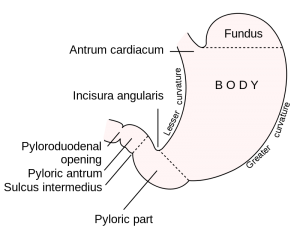Pyloric stenosis – Infantile hypertrophic pyloric stenosis (IHPS)
Pyloric stenosis is a narrowing of the stomach outlet also called pylorus. This usually occurs in infants (2-8 wks) and hence also called Infantile hypertrophic pyloric stenosis.

Pyloric stenosis is a narrowing of the stomach outlet also called pylorus. This usually occurs in infants (2-8 wks) and hence also called Infantile hypertrophic pyloric stenosis.

No definitive causative factors have been identified. Both genetic and enviromental factors seems to play the role. There is clear male preponderance with ratio of 2:1 to 5:1. Its incidence is 1.5 to 4.0 per 1000 live birth. There is an increased risk to first born male child with a positive family history and certain blood ABO types.
Presentation:
Other symptoms are:
A definitive diagnosis can be made in 75% of infants by palpation of enlarged pylorus called as “olive” in right upper abdomen
Signs of dehydration, such as dry skin and mouth and dry diapers
Ultrasound of the abdomen: Pyloric muscle thickness more than 3mm and pyloric channel length of more than 16mm in infant younger than 30 days is diagnostic. Some centers consider pyloric diameter more than 14 mm to be abnormal.
Treatment for pyloric stenosis involves surgery -called Pyloromyotomy. It can be done by Open or Laparoscopic technique
Surgery usually relieves all symptoms. As soon as several hours after surgery, the infant can start small, frequent feedings.